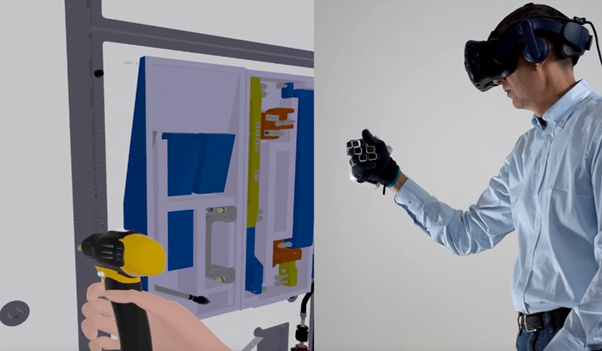by Gijs den Butter – SenseGlove
In the evolving landscape of virtual reality (VR) training, realism and interactivity are key to achieving meaningful learning outcomes. The PRESENCE project is pushing the boundaries of what’s possible in XR (Extended Reality) by integrating advanced haptic technologies that bring the sense of touch into immersive environments. These innovations are not only enhancing user experience, they’re also opening new possibilities for improving skill acquisition and learning retention in professional training..

Touch: The Missing Link in XR Training
While XR has proven highly effective for simulating complex environments, traditional setups often rely heavily on visual and auditory cues. Yet, for tasks requiring procedural knowledge – like assembling machinery, handling hazardous materials, or performing medical procedures – feeling the task is just as important as seeing it. This is where haptics come in.
By incorporating tactile sensations such as pressure, force, texture, and vibration, haptics makes virtual interactions feel real. The PRESENCE project builds on this principle, enabling localized, multi-modal haptic feedback that adapts to different body parts through an advanced spatial targeting mechanism. With PRESENCE’s haptics API and the use of the MPEG standard, developers can now create rich, cross-device haptic effects for realistic training scenarios.
From Gloves to Vests: A Multi-Modal Ecosystem
A defining aspect of PRESENCE is its support for a variety of haptic hardware – ranging from gloves with active force-feedback to wideband haptic vests and cushions. Devices like the SenseGlove Nova 2, which features programmable palm pressure feedback, allow users to physically feel when they grasp or press an object. Meanwhile, haptic vests such as Actronica’s Skinetic and Razor’s Freyja cushion provide broad-area stimulation, enabling the reproduction of body hits, pressure, or environmental cues.
What makes this approach unique is not only the diversity of haptic modalities—tactile, kinesthetics, passive, and active—but also the precise control it offers over each of them. PRESENCE’s system supports body-part-specific activation through a “target and range” mechanic, allowing developers to activate only relevant actuators depending on the task. For example, a virtual burn hazard might trigger a vibration on the user’s hand but not on their chest – creating a more intuitive and efficient experience.
Enhanced Embodiment and Learning Outcomes
Research from the haptics field – compiled in a recent white paper by SenseGlove – shows that haptic feedback significantly enhances embodiment: the sensation of “being” in the virtual environment. This deeper sense of immersion has been linked to better procedural learning and retention. Studies demonstrate that users who train with haptic feedback perform tasks faster, with greater accuracy, and retain skills longer than those using standard VR controllers.
For example, one study found that force and vibration feedback improved surgical simulation performance by over 30%, even under cognitive load. Another revealed that trainees using haptic gloves in a VR fire safety scenario reported a stronger sense of embodiment and were better able to recall the steps a week later.
What’s Next in PRESENCE
While these early implementations are promising, the next phase of the PRESENCE project will focus on validating this multi-device haptics system in real-world demonstrators. The content creation pipeline will be further refined to allow instructional designers to craft reusable, cross-device haptic scenarios. These will be tested in collaborative training environments – helping users not only act but feel their way through complex procedures.
By embedding natural touch into virtual training, PRESENCE is not just enhancing XR – it’s shaping the future of how we learn hands-on skills in the digital world.
